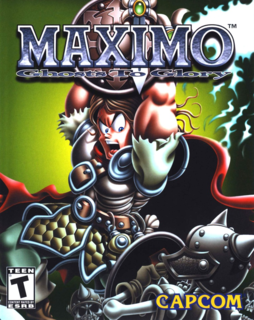If nothing else, it succeeds in capturing the spirit of Ghosts n' Goblins.
---
If I could sum up this review in one sentence, it would be this: Maximo: Ghosts to Glory is basically what a next-gen Ghouls N’ Ghosts would be like. That’s my review, thanks for stopping by.
Stupid intro aside, Maximo really would be the Ghouls N’ Ghosts of the next generation. In fact, Maximo pays homage to the classic Capcom platformer in several ways, right down to the plot. Make no mistake, though; Maximo is a brand-new game that happens to borrow some of GnG’s elements.
After returning from a victorious battle, Maximo discovers that his kingdom has changed; undead creatures now inhabit the once-pleasant fields; his council, which consisted of four sorceresses, was now separated; but worst of all, Maximo’s love of his life and bride-to-be, Sophia, was forced to marry Achille, Maximo’s advisor-turned-evil ruler of the undead. Achille, using a giant drill, dug into the underworld and claimed every soul for his own. After being killed by Achille, Maximo finds himself face-to-face with Death, a.k.a. The Grim Reaper. Death isn’t happy about Achille taking his property, so he decides to enlist Maximo’s help; Grimmy will return Maximo to the surface only if Maximo agrees to help the scythed one reclaim his souls, not to mention take care of Achille. Naturally, Maximo agrees to the proposition, if it meant evening the score with Achille.
Maximo contains 30 levels, broken down to five worlds with six levels each. In each world, you must clear each level before you can fight the world’s boss. The boss fights are fun since you can’t just walk up to a boss and strike him. Each boss has a weakness, but they aren’t obvious. Instead of finding Contra-esque glowing things that say “hit me,” you actually have to inspect your adversary, and in some cases, your surroundings as well. Most basic enemies can’t be defeated with just a simple sword swipe, either. When you come across new enemies, expect to take a few hits before figuring out how to defeat them. Maximo has a large arsenal of abilities, such as a double strike or a “Gold Seeker,” which locates secret treasure whenever you perform a downward stab. Maximo can hold many abilities at a time, but favourites can be locked onto Maximo’s belt, so you won’t lose them after death. Initially, up to three abilities can be locked at a time, but as you rescue sorceresses, this number increases.
In true Ghouls N’ Ghosts fashion, Maximo can lose his armor if you take enough damage, and end up wearing nothing but a pair of boxers. Unlike GnG, though, you won’t lose pieces of armor after one single hit. Maximo is more forgiving, fortunately. It should be noted that Maximo doesn’t use today’s platformer conventions; instead, Maximo plays more like a 16-bit platformer. You have a limited number of lives, and you can only continue the current level if you have enough “Death Koins,” which can be obtained by collecting 50 Spirits. You can still save your progress to a memory card, but even that comes at a price. You should be grateful--if Capcom really wanted to be old-school, they could’ve opted for a password system (to quote someone from a forum, Maximo “looks new, but plays old”). Maximo really is a game that would appeal to those who grew up playing earlier platformers such as Super Mario Bros. 3 or Ghouls N’ Ghosts--you know, back when platformers were actually difficult, and not so much a fetch quest. But in all honesty, I think non-old-schoolers can enjoy this game. They should just expect a challenge greater than what we see today.
For a game that plays old-school, Maximo looks great. The graphics are definitely above average, and the lighting effects are well done. Maximo was originally supposed to be a more serious-looking game that probably would have gotten an M rating by the ESRB. The comical, less-realistic look suits Maximo well, and I’m glad that Capcom went this route. Sound is nothing to write home about; Maximo is one of those games where the sound is “not great, but not bad, either.” Some of the tracks are remixes of the classic Ghouls N’ Ghosts first stage theme (you know which one I’m talking about).
There are a few things that will likely annoy gamers, especially those who have played 3D platformers before. You can probably guess what those problems are, because you’ve likely experienced them at least once: the camera and targeting. You have no control over the camera except to point it in the direction Maximo’s facing. This isn’t bad, except the camera doesn’t function if there’s a wall behind Maximo, which often leads to having to make tricky jumps (which often don’t end in success). Targeting is a problem in combat, because, well—there is no targeting. Sometimes, you’ll miss your target (especially if you have Second Strike), which will often result in taking some damage. The lack of targeting isn’t a big deal, but the camera detracts from the gameplay, because other 3D platformers have little or no problems, yet most developers are apparently unable to make a decent camera.
Flaws aside, Maximo is a game for those who want a little challenge, and not have to collect a crazy number of objects, something associated with today’s platformers (I’m looking at you, Donkey Kong 64). It’s also a game for those who get all teary-eyed when they think about Ghouls N’ Ghosts--they’ll love this game. Other gamers shouldn’t feel intimidated by Maximo; the 8-bit/16-bit games were much harder. The game really is straightforward--no treasure hunting outside of money, no massive worlds to explore, and no nonsense…just a good ol’ time.

